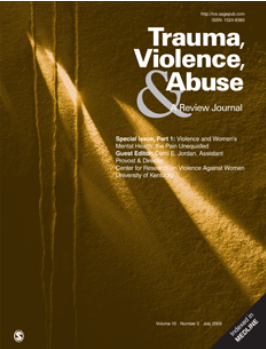性暴力与羞耻:一项元分析
IF 5.4
1区 社会学
Q1 CRIMINOLOGY & PENOLOGY
引用次数: 0
摘要
尽管性暴力(SV)被认为会增加羞耻感,但 SV 与羞耻感之间的关系尚未得到量化。解决这一空白对于为幸存者制定有针对性的干预措施至关重要,因为羞耻感是多种形式精神病理学的跨诊断风险因素,也是寻求服务的障碍。本荟萃分析首先研究了暴露于 SV 的个体是否比未报告暴露于 SV 的个体表现出更高的羞耻感。其次,我们评估了 SV 严重程度与羞耻感严重程度之间的关联强度。我们在七个数据库中检索了从开始到 2023 年 6 月发表的研究。对至少 10 名参与者的 SV 和羞耻感进行评估的原创研究符合纳入条件。随机效应模型检验了 SV 幸存者与未暴露于 SV 的个体之间的羞耻感差异,并量化了 SV 严重程度与羞耻感严重程度之间的关联。对 53 项研究(97 项效应,N = 15,110 )进行的元分析表明,暴露于 SV 的个体与未暴露于 SV 的个体相比,羞耻感更高 ( g = 0.55),在 SV 发生时间(童年/青春期或成年)和羞耻感亚型(特质、身体、创伤相关)方面的影响中等。SV严重程度与羞耻感呈中度相关(r = 0.20),在儿童/青少年SV严重程度与创伤相关羞耻感之间发现了较强的相关性,在青少年/成人SV严重程度与创伤相关羞耻感和身体羞耻感之间发现了较小的影响。偏差风险评级、是否经历过接触性创伤、样本类型和性别对某些模型有调节作用。我们的研究结果表明,羞耻感是 SV 的一个重要临床相关因素。针对羞耻感的干预措施可能会为幸存者带来更积极的结果。本文章由计算机程序翻译,如有差异,请以英文原文为准。
Sexual Violence and Shame: A Meta-Analysis
Although sexual violence (SV) has been hypothesized to increase shame, the relationship between SV and shame has not been quantified. Addressing this gap is essential for developing targeted interventions for survivors, as shame is a transdiagnostic risk factor for numerous forms of psychopathology and a barrier to service-seeking. This meta-analysis first examines whether individuals exposed to SV demonstrate higher shame than individuals who reported no SV exposure. Second, we assessed the strength of the associations between SV severity and shame severity. Seven databases were searched for studies published from inception to June 2023. Original studies that assessed SV and shame in at least 10 participants were eligible for inclusion. Random effects models examined shame differences between SV survivors and non-SV–exposed individuals and quantified the association between SV severity and shame severity. Meta-analyses of 53 studies (97 effects, N = 15,110) indicated that individuals exposed versus those not exposed to SV experience higher shame ( g = 0.55), with medium effects found across SV timing (childhood/adolescence or adulthood) and shame subtypes (trait, body, trauma-related). SV severity was moderately associated with shame ( r = .20), with strong correlations found between child/adolescent SV severity and trauma-related shame, and small effects found between adolescent/adult SV severity and trauma-related and body shame. Risk of bias ratings, whether contact SV was experienced, sample type, and gender moderated some models. Our findings suggest that shame is a clinically significant correlate of SV. Interventions that address shame may contribute to more positive outcomes for survivors.
求助全文
通过发布文献求助,成功后即可免费获取论文全文。
去求助
来源期刊

Trauma Violence & Abuse
Multiple-
CiteScore
13.60
自引率
7.80%
发文量
131
期刊介绍:
Trauma, Violence, & Abuse is devoted to organizing, synthesizing, and expanding knowledge on all force of trauma, abuse, and violence. This peer-reviewed journal is practitioner oriented and will publish only reviews of research, conceptual or theoretical articles, and law review articles. Trauma, Violence, & Abuse is dedicated to professionals and advanced students in clinical training who work with any form of trauma, abuse, and violence. It is intended to compile knowledge that clearly affects practice, policy, and research.
 求助内容:
求助内容: 应助结果提醒方式:
应助结果提醒方式:


